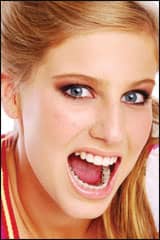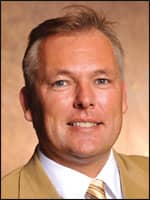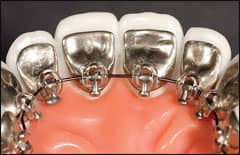by Christopher Piehler
Dirk Wiechmann, DDS, helps patients and other orthodontists learn to love lingual
 |
Orthodontic Products: Tell me a little bit about your history as an orthodontist. How long have you been in practice and how long have you been treating patients with lingual appliances?
Dirk Wiechmann, DDS, MS: I have been in practice now for about 14 years—11 in my current practice and before that, I worked at the University of Munster in Germany and was a private practitioner in Osnabruck. I have been treating patients with lingual appliances right from the beginning of my orthodontic career.
OP: What percentage of patients would you say that you treat lingually?
Wiechmann: We have a nearly completely lingual practice. In our office today it is about 90%. All of the adult patients have lingual, and 80% of the children have lingual.
OP: What lingual system do you use?
Wiechmann: We use the Incognito™ Appliance System, which is offered by 3M Unitek as the iBraces™ Appliance System in the United States.
OP: And you were involved in the development of the system?
 |
| Dirk Wiechmann, DDS |
Wiechmann: Yes. When we treated patients with earlier generations of lingual appliances, we experienced some inconveniences, and so we thought about how to make this easier for the practitioner and, at the same time, get better results for the patient.
And so, together with a group of engineers and other orthodontists, we created the Incognito System to enable a larger number of orthodontists to incorporate lingual treatment in their practices.
OP: What issues were you looking to address?
Wiechmann: It was mainly three issues. Patients were feeling uncomfortable with the previous-generation lingual braces because they were much thicker. And, for the orthodontist, there was the issue that the brackets kept coming off, which they then had to rebond and repair, taking a lot of chairtime. And finishing the case was also difficult. So we thought about something that could make this easier and, combined with new rapid prototyping technology and wire-bending robots, I think that we found a quite acceptable solution for this.
OP: Can you tell me how you addressed each of those three deficiencies that you just named?
Wiechmann: Yes. For example, the first one is patient discomfort, so it is mainly two things. In the old systems, they used very big brackets. The Incognito System bracket itself, the bracket body, is only 1/3 of what other lingual brackets were before. And because our brackets are 100% customized, you can align each single bracket separately and adapt it to the teeth of the patient so that you’re getting a maximally flat bracket that has all of the functional features that you need to treat.
 |
| The Incognito Appliance System uses robotically bent archwires to deliver custom treatment for each patient. |
The other thing is that, when you treat on the lingual surface, the problem is that teeth have different thicknesses. So, for example, when you look at your central incisor, it is the tooth that is completely in the middle and, from the inside to the outside, it is much thinner than if you go to the sides in your mouth where there is a molar that is nearly three or four times as big. These differences in tooth thickness have to be compensated by something. And in the old lingual techniques, they were compensated by using bigger brackets in the frontal area. With the Incognito System, we compensate for this with the wires now, which are bent by the robot. The Incognito Appliance is a very flat appliance and very precise at the same time.
Another point is bracket debonding. When you look at our appliance and the bracket base, the bracket itself is very flat, but the base is quite large. So you have a very big bonding area. A bigger bonding surface means better adhesion, so less bracket loss.
OP: That makes sense.
Wiechmann: And the third thing is this: When you have an appliance, the part, finally, that we all look at is the outer part of the teeth, right?
OP: Right.
Wiechmann: As I mentioned, finishing cases was difficult with previous lingual systems. When you have an appliance far away from the outer part, and you have a very big appliance, it gets very difficult to control something that is far away from your appliance, namely the outer part. So with thicker appliances, finishing is more difficult than with thinner appliances. Minimizing the bracket body of our system not only makes the system more comfortable for the patient, it makes finishing much easier.
Also, the brackets and wires that we use have completely the same fit. So when you place our finishing wire in the bracket slot, there is no play. We are able to adjust the teeth to the precise position that we want them. That is why, in finishing wires, we do not need overcorrections or adjustments; we just go to the ideal, and that is it.
OP: How does this system affect your workflow in the clinic? Does it take more or less chairtime per appointment when compared to traditional labial appliances?
Wiechmann: I can tell you that, about 10 years ago when we had a lingual day—so we were seeing only lingual patients—we were seeing about, let’s say, 40 to 50 patients per day, maximum. Today, when we have a lingual day, we see between 85 and 105 patients per day. Experience makes a difference.
And it’s very rare, but when we have labial days—because we don’t have so many labial patients—I certainly could not see any more labial patients today than I can see lingual patients. But this is a question of the appliance that you use and also the training of your team, right?
OP: How did you train your staff on the Incognito System? How long did that take?
Wiechmann: My staff has always done lingual. They have always had a high workload of lingual patients. And they love it because it is something that makes them unique, because dental assistants don’t normally see lingual patients. In our office, there are many lingual patients coming in for treatment.
Also, I have a professor from the University of India working in my office, overseeing the assistants and advising them as they treat lingual patients. The staff appreciate this a lot because it makes their jobs a bit more interesting.
OP: And on the patient side, about how long does the average patient take to get used to having lingual braces?
Wiechmann: To my mind, this depends on the age of the patient. If you have an older patient—let’s say around 60 years old—it normally takes that patient a bit longer to adjust. But if you have somebody who is young, then it takes a day or two.
With our adult patients, we normally bond the lower arch first and then the upper arch at the next appointment, 3 or 4 weeks later. And when they come for the second arch bonding, they are completely fine. So I would say that the adjustment can take a maximum of 3 weeks. But in younger patients, it is a day or 2, or 3, not more.
OP: What about treatment time?
Wiechmann: I think that we can show that we can deliver better results in a shorter treatment time than with labial cases. So, at the moment, we are doing some prospective clinical trials together with several universities to quantify the quality of our finishing results and to put this in relation with the treatment time. I think that we can show in the long term that our lingual treatment time compared with our labial cases is a bit shorter, whereas our results are certainly better.
OP: Do you have a general sense of the difference in average treatment time between labial and lingual?
Wiechmann: In my office, I have just done a little presentation about the last 3 months in 2008. We consecutively debonded 26 children and adolescents with lingual braces. The average treatment time was 18 months—extraction cases together with very, very complex cases. Overall, it was 18 months. You would have to compare this to a control group with labial to get the scientific comparison.
OP: Have you found limitations to the system or things that you might want to improve?
Wiechmann: At the moment, the only limitation is the orthodontist himself and his training. If you have good training and know what you are doing, then I think that you can treat the same patients that you do with labial appliances, in a shorter treatment time, with better results. The limitations that you have are the general limitations for fixed-appliance therapy, such as cases of patients with extremely bad oral hygiene or acute periodontitis.
OP: Do you train other orthodontists to use Incognito?
Wiechmann: Yes, I teach at the Medical School of Hanover. We have a master’s degree over there—a Master of Science in Lingual Orthodontics—which is a 2-year program. Also, at the University of Paris VII, we have what the French call DiplÔme Universitaire in Lingual Orthodontics, which also lasts 2 years.
OP: Do you travel outside of Europe to do any teaching?
Wiechmann: Yes, I offer 2-day courses on getting started with the Incognito System. Attendees learn about the development of the system, how to select suitable appliances for various malocclusions, and clinical procedures.
They get to practice what they are learning on typodont models. I offer these courses all over the world, including in the United States.
OP: What tips would you offer other orthodontists looking to start doing lingual?
Wiechmann: I think that it is very important to know that lingual orthodontics is something that you cannot learn in 5 minutes. So I think that there is a learning curve, and you have to be really serious to learn this.
And you better take your team with you right from the beginning to learn this. It is like everything: when something is new, the old stuff is always easier. But lingual is, by nature, no more difficult than labial. The only problem is that, at the normal universities that do orthodontic training, nobody ever sees the lingual brackets, and nobody is treating lingual cases. This will change in the future.
But, at the moment, from here in Germany, we have about 2,500 orthodontists, and only very, very few of them have seen a lingual case in their education at the university. And it is exactly the same in the United States. So it is a new technique that you have to learn. But if you are serious, willing, and ready to learn it, then you will have a huge advantage compared with a competitor that is not schooled in lingual orthodontics.
I think that the success that you have is absolutely linked to the motivation of the orthodontist and his staff. I live in a very, very small town, Bad Essen. We have only about 5,000 inhabitants here, yet I have about 550 to 600 lingual cases going on.
|
To read more articles on this topic, for “lingual”. |
I don’t know how the competition situation is in the United States. But I see that lingual orthodontics is going especially well. If there is competition among the orthodontists, especially for the younger ones, if they want to have the extraordinary and something that is not delivered by every orthodontist, then I think that lingual can be very, very interesting.
Dirk Wiechmann, DDS, MS, is in private practice in Bad Essen, Germany. He is the scientific director of DiplÔme universitaire en orthodontie linguale (DUOLG) at the University of Paris VII. He is also an honorary associate professor at the Faculty of Dentistry, University of Hong Kong, and scientific director of the Master of Science Program in Lingual Orthodontics at the Medical School of the University of Hanover, Germany. He is a Diplomate of the German Board of Orthodontics. He can be reached at








